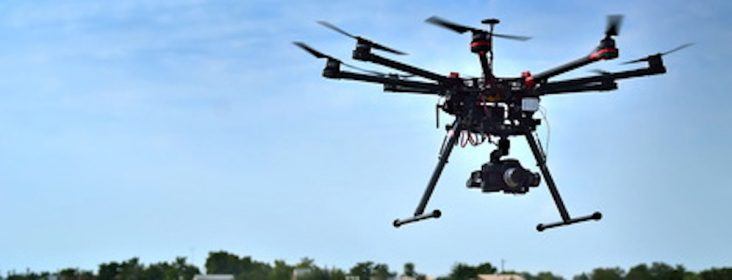Drone interferes with Arkansas Forestry Commission wildfire detection flight
by November 29, 2017 8:23 pm 936 views

Flying with a drone for video and photo productions
An Arkansas Forestry Commission (AFC) wildfire detection flight had to be rerouted Tuesday over Sharp County after authorities were notified an unmanned drone was flying in the airspace above a fire. This is the second time in the last year a detection flight was impacted by drones in the sky, Arkansas Department of Agriculture Communications Director Adriane Barnes told Talk Business & Politics. AFC doesn’t know who owned the drone, and local authorities in Sharp County are investigating the incident.
“This was not a dramatic situation, but we don’t want it to ever endanger our flight crews,” Barnes said.
Pilots cannot detect drones other than seeing them in the sky. If AFC hadn’t been told about the drone in Sharp County, there would have been no way for the crew to know it was there, she said. Detection crews fly routes around the state to spot wildfires and help assist those on the ground with aerial information. If drones are reported in an area, AFC will ground any aircraft in the area or it will send it to another location. This could hamper firefighting efforts, Barnes said.
“When drones are flying near wildfires we cannot use aircraft to monitor the fire,” state forester Joe Fox said. “Pilots provide a valuable perspective to our dozer crews by giving a description of fire behavior from the air, especially when it comes to warning firefighters about a change in wind direction, nearby hazards, or the proximity of nearby homes. We ask that drone operators stay away from wildfire emergencies for the safety of everyone involved.”
The AFC had seven planes flying Tuesday along established routes throughout Arkansas. In all, the AFC has 15 planes — 13 are used for fire detection and two are used to assist single engine air tanker planes in aerial water drops. Pilots flew routes through the Thanksgiving holiday and have logged over 250 flight hours altogether in the last week. Flight crews are trained to identify smoke or other signs of wildfire, and report those findings to the AFC dispatch center. They are trained to assist dozer crews with assessing the size, damage, and intensity of flames.
Wildfires subsided statewide Wednesday as rains and higher humidity returned to the Natural State. At least 76 wildfires that have burned about 2,000 acres were suppressed by AFC crews from Sunday through Tuesday. At least 28 fires burned 458 acres on Wednesday. An estimated 25,000 acres may have already burned in Arkansas this year, the most since 2012. Those numbers don’t include any fires on acres owned by the federal government. Barnes doesn’t think the state will surpass the 34,000 acres burned that year, but there are still concerns it could reach those levels.
“I don’t think it’s going to be worse … but anything is possible. We still have the month of December,” Barnes said.
From 2013 to 2016, the number of burned acres was lower than average, and that creates another problem, Barnes said. It means there is more dry underbrush, or fuel, available, she said.
Arkansas wildfire patterns run in five year blocks, Conway County forest ranger Wes McKinney told Talk Business & Politics. Arkansas’ peak fire months are from February to April and from August to October. The last two years have been unusual because August has been wetter both years than the average. In 2016, and 2017, wildfires have been more prevalent in November than the norm. Dry weather, low humidity, mild temperatures, and winds are the catalysts for wildfires, he said.
These conditions have been ongoing during the last several weeks and it’s normally rainy in November across the state. By this time of year, the ground and foliage is saturated with water, he said. Fighting fires in Arkansas is different than those in the mountainous west, McKinney said. There are more roads and creeks that firefighters can use to help contain blazes in the state. McKinney has fought fires in the west, and in those states fires erupt often in isolated places and are much larger and require a lot more resources to contain, he said.
Lightning, inadvertent sparks from machines such as bush hogs in fields, discarded cigarettes, and other triggers cause wildfires. But, the two main causes of wildfires are arson and people burning debris on their property. Arkansas spends millions fighting wildfires each year, and it’s hard to quantify exactly how much is spent because of the many agencies involved, the training, equipment, and even the in-kind labor provided by volunteer firefighters and others, Barnes said. Those costs can be curtailed if residents will adhere to good burning practices at their homes, Barnes said.
Arkansas has 47 burn bans which are declared by county judges in the following counties: Arkansas, Ashley, Baxter, Bradley, Boone, Carroll, Chicot, Clark, Cleburne, Conway, Cross, Dallas, Drew, Faulkner, Franklin, Fulton, Garland, Grant, Hempstead, Hot Spring, Howard, Independence, Jefferson, Johnson, Lawrence, Lincoln, Lonoke, Madison, Marion, Miller, Monroe, Montgomery, Ouachita, Perry, Pike, Poinsett, Polk, Prairie, Pulaski, Randolph, Saline, Searcy, Sharp, Stone, Van Buren, White, and Yell.
